The Amish, a traditional Christian group known for their simple and modest lifestyle, have unique bathing practices that reflect their commitment to simplicity and self-sufficiency.
Table of Contents
Traditional Amish Bathing Practices
Have you ever wondered how the Amish bathe? The Amish are known for their simple and traditional way of life, and this extends to their bathing practices as well. In this article, we will explore the traditional Amish bathing practices and shed light on how they keep themselves clean and fresh without the use of modern amenities.
The Amish believe in living a simple and humble life, and this is reflected in their bathing routines. Unlike most of us who take daily showers or baths, the Amish typically bathe only once a week. This may seem surprising to some, but it is a way for them to conserve water and energy, as well as to prioritize their time for other important tasks.
When it comes to bathing, the Amish prefer to use a washbasin and a pitcher of water. They fill the washbasin with warm water and use a cloth or sponge to clean themselves. This method allows them to conserve water, as they only use what is necessary for their bathing needs. It also gives them a sense of simplicity and connection to nature, as they are not relying on modern plumbing systems.
In addition to their weekly baths, the Amish also practice daily hygiene routines. They wash their faces and hands multiple times a day, using a basin and water. This helps them to stay clean and fresh throughout the day, without the need for a full bath. They also brush their teeth regularly, using a toothbrush and toothpaste, just like the rest of us.
One interesting aspect of Amish bathing practices is the use of homemade soaps. The Amish are known for their skills in making natural and homemade products, and this extends to their soaps as well. They make their own soaps using simple ingredients like lard, lye, and essential oils. These homemade soaps are gentle on the skin and do not contain any harsh chemicals or additives.
Another unique aspect of Amish bathing practices is the use of communal bathhouses. In some Amish communities, there are communal bathhouses where members of the community can go to take a bath. These bathhouses are simple structures with separate rooms or stalls for privacy. They provide a space for the Amish to come together and socialize while taking care of their personal hygiene.
It is important to note that not all Amish communities have communal bathhouses. Some Amish families have their own private bathing facilities, while others may use a designated area in their homes for bathing. The specific bathing practices can vary from community to community, but the underlying principles of simplicity and conservation remain the same.
In conclusion, the Amish have a unique approach to bathing that reflects their simple and traditional way of life. They bathe once a week using a washbasin and pitcher of water, and practice daily hygiene routines using a basin and homemade soaps. Some communities have communal bathhouses, while others have private bathing facilities. Through their bathing practices, the Amish prioritize simplicity, conservation, and a connection to nature.
The Role of Water in Amish Daily Life

The Amish are known for their simple and traditional way of life, which includes a strong emphasis on community, family, and faith. One aspect of their daily routine that may seem unusual to outsiders is their bathing practices. Unlike most people who take daily showers or baths, the Amish have a different approach to personal hygiene.
Water plays a significant role in the daily life of the Amish. It is not only used for drinking and cooking but also for various household chores. However, when it comes to bathing, the Amish have a more practical and conservative approach. They believe in conserving water and using it sparingly, as it is a precious resource.
Instead of taking showers or baths, the Amish prefer to wash themselves using a method called “sponge bathing.” This involves using a basin of warm water, a washcloth, and soap. The Amish typically perform this ritual in the morning, before starting their day. They believe that cleanliness is important, but excessive use of water is wasteful and goes against their values of simplicity and humility.
Sponge bathing is a simple and efficient way to cleanse the body. The Amish use a washcloth to wet their skin and then apply soap to lather up. They carefully scrub each part of their body, making sure to clean themselves thoroughly. Afterward, they rinse off the soap by wringing out the washcloth in the basin of water. This process is repeated until they feel clean and refreshed.
The Amish also believe in the healing properties of water. They often incorporate water into their daily routines as a way to relax and rejuvenate. For example, some Amish families have a tradition of taking foot baths in the evening. This involves soaking their feet in a basin of warm water, often infused with herbs or essential oils. It is a soothing and therapeutic practice that helps them unwind after a long day of work.
In addition to sponge bathing and foot baths, the Amish also make use of natural bodies of water for bathing. Many Amish communities have access to rivers, lakes, or ponds, which they consider a blessing. During the summer months, it is not uncommon to see Amish families gathering at these bodies of water for a refreshing swim. They view it as a way to connect with nature and enjoy the simple pleasures of life.
While the Amish may have a different approach to bathing than most people, their practices are rooted in their values and beliefs. They prioritize simplicity, conservation, and community over excessive use of resources. By embracing a more modest way of bathing, the Amish demonstrate their commitment to living a humble and sustainable lifestyle.
In conclusion, the Amish have a unique bathing routine that reflects their values and way of life. They prefer sponge bathing, using a basin of warm water and a washcloth, as a practical and conservative way to cleanse their bodies. They also incorporate water into their daily routines for relaxation and rejuvenation. By embracing simplicity and conservation, the Amish show us that there are alternative ways to maintain personal hygiene while respecting the environment.
Hygiene and Cleanliness in Amish Communities
Have you ever wondered how the Amish keep themselves clean? With their simple and traditional way of life, it’s natural to be curious about their hygiene practices. In Amish communities, cleanliness is highly valued, and they have developed unique methods to maintain their personal hygiene without the use of modern amenities.
One of the most common questions people have is how the Amish bathe. Unlike most of us who take daily showers or baths, the Amish have a different approach. They believe in conserving resources and living a simple life, which extends to their bathing habits. Instead of using running water, they prefer to use a method called “sponge bathing.”
Sponge bathing involves using a basin of water and a washcloth or sponge to clean oneself. The Amish typically heat water on a stove or in a kettle and pour it into a basin. They then dip the washcloth or sponge into the warm water and use it to clean their bodies. This method allows them to conserve water while still maintaining their personal hygiene.
While sponge bathing may seem unusual to some, it is an effective way for the Amish to stay clean. They focus on the essential areas, such as the face, underarms, and private parts, ensuring that they are fresh and hygienic. This method also allows them to be mindful of their water usage, as they only use what is necessary.
In addition to sponge bathing, the Amish also place great importance on cleanliness in their homes. They believe that a clean and tidy living space is essential for maintaining good health. Regular cleaning and tidying up are part of their daily routine, ensuring that their homes are free from dirt and germs.
The Amish also have a unique approach to laundry. Instead of using electric washing machines, they use a manual method called a “wringer washer.” This device consists of a tub filled with water and soap, where clothes are agitated by hand. Afterward, the clothes are passed through a wringer to remove excess water before being hung to dry.
This traditional method of doing laundry not only saves electricity but also allows the Amish to engage in physical activity while completing their chores. It is a communal activity, with family members often helping each other with the washing. This not only fosters a sense of togetherness but also ensures that everyone has clean clothes.
While the Amish may have different bathing and laundry practices, it is important to note that they still prioritize cleanliness and hygiene. They understand the importance of maintaining personal and household cleanliness for their overall well-being. Their methods may be different from what we are accustomed to, but they have proven to be effective for generations.
In conclusion, the Amish have developed unique methods to maintain their personal hygiene and cleanliness. Through sponge bathing, they conserve water while still ensuring that they are clean and fresh. Their manual approach to laundry not only saves electricity but also promotes physical activity and togetherness. The Amish’s commitment to cleanliness is a testament to their simple and traditional way of life.
Cultural Perspectives on Bathing Among the Amish
Have you ever wondered how the Amish bathe? It’s a question that many people have, as the Amish are known for their simple and traditional way of life. In this article, we will explore the cultural perspectives on bathing among the Amish and shed some light on their unique practices.
The Amish, a religious group that originated in Europe, place a strong emphasis on simplicity and humility. This is reflected in their daily routines, including their bathing habits. Unlike most modern societies, the Amish do not have access to running water in their homes. Instead, they rely on alternative methods to keep themselves clean.
One common practice among the Amish is the use of a washbasin. They fill a basin with water and use it to wash their face, hands, and other body parts. This method allows them to conserve water and maintain their simple way of life. It also serves as a reminder of the importance of humility and modesty in their culture.
Another traditional method of bathing among the Amish is the use of a washcloth. They wet the cloth with water and use it to clean their bodies. This method is similar to using a sponge bath and is an efficient way to stay clean without the need for a shower or bathtub.
In addition to these methods, the Amish also make use of natural remedies for personal hygiene. For example, they often use homemade soaps and shampoos that are made from natural ingredients such as lye and herbs. These products are gentle on the skin and hair and are in line with their commitment to simplicity and natural living.
It’s important to note that the Amish do not completely abstain from bathing. They do bathe regularly, but their methods may differ from what we are accustomed to in modern society. Their bathing practices are deeply rooted in their cultural and religious beliefs, and they have found ways to adapt to their unique circumstances.
The Amish also view bathing as a communal activity. In some communities, they have designated bathing areas where members of the community can gather to bathe together. This not only promotes a sense of community and togetherness but also allows them to conserve water and resources.
It’s fascinating to see how different cultures approach something as basic as bathing. The Amish have found ways to maintain their traditions and values while still meeting their personal hygiene needs. Their practices may seem unconventional to some, but they serve as a reminder of the importance of simplicity and humility in our daily lives.
In conclusion, the Amish have a unique perspective on bathing that is deeply rooted in their cultural and religious beliefs. They rely on alternative methods such as washbasins and washcloths to keep themselves clean. They also make use of natural remedies and view bathing as a communal activity. While their practices may differ from what we are accustomed to, they serve as a reminder of the importance of simplicity and humility in our lives. So the next time you take a shower or bath, take a moment to appreciate the cultural perspectives on bathing among the Amish.
Conclusion
In conclusion, the Amish typically practice bathing in a simple and traditional manner, often using a washbasin and pitcher or a sponge bath. They prioritize modesty and simplicity in their daily routines, reflecting their commitment to a traditional way of life.



